An Energy-Efficient Framework for WBAN in Health Care Domain
Abstract
This paper provides the deep detailed information related to the importance of link-aware energy-efficient communication between sensor nodes working in the health care domain. Today, in the modern field of science and technology, wireless sensor networks are playing a vital role in real-life applications including medicine, health care, and disaster management. WBAN applications nowadays are successfully used in medical health care. WBAN application is classified into two subtypes which include wearable WBAN and implantable WBAN. For this reason, the patient health condition can be monitored anywhere and at any time. Mostly, the researchers, in the health care domain, are using latest communication standards including 3G, WiMax, Bluetooth, and Zigbee standards. In this paper, we had proposed an energy-efficient framework (M-DSDV-RMCP routing protocol) for WBAN. The proposed framework is based on the DSDV routing protocol based on the RMCP routing protocol.
1. Introduction
The health care applications, related to wireless sensor networks, focus on the improvement of medical facilities especially for elderly people living at home. The design constraints, related to pervasive health care systems in body area network devices, includes radiofrequency identifier tags, electrocardiogram sensors, and accelerometers that are worn by individuals. Different protocols and standards had been designed for health care systems including IEEE 802.15.4 and IEEE 802.15.6 for Zigbee and WBAN health care standard. In pervasive health care systems, different medical applications had been designed for remote patient monitoring [1]. These most common applications used nowadays includes Mobi Health, Code Blue, Alarm Net, Life Guard, Med. Supervision, WLAN ECG, Mobile ECG, and AWARENESS [2, 3]. A patient alarm monitoring system is typically designed for elderly people living at home in case of critical emergency circumstances. The WBAN applications are responsible for monitoring health care of patients by using lightweight sensors mounted on the human body. The lightweight sensor devices are used in monitoring the health of patients typically in cardiovascular diseases, cancer detection, glucose level monitoring, and asthma and organ monitoring. Compared with the existing technologies such as WLAN, WBAN enables the communication around the human body by using wireless computing devices [4].
The communication in WBAN is classified into two subtypes including intrabody communication and extrabody communication. The multitier architecture of the wireless body area network has been designed for health care systems are mentioned as follows in Figure 1. The four-tier architecture consists of an intrabody sensor network communication module referred as Tier-1. Tier-1 consists of sensor nodes deployed on the human body. The sensors deployed on the human body are ECG sensors, ear sensors, blood pressure sensors, ECG sensors, EMG sensors, and body motion sensors. Tier-2 consists of the interbody sensor network communication module referred to as the access point. This module is responsible to receive the health status information from Tier-1 and routes this information to Tier-3. Tier-3 consists of the beyond body network communication-based infrastructure. This module is responsible for transferring data from Tier-2 (access point) to Tier-3. Tier-3 is also responsible for providing wireless health care services by using the Internet [2]. Tier-3 also consists of the data management unit for analysis and intelligent decision-making by doctors and emergency rescue staff at hospital located within Tier-4 [5].
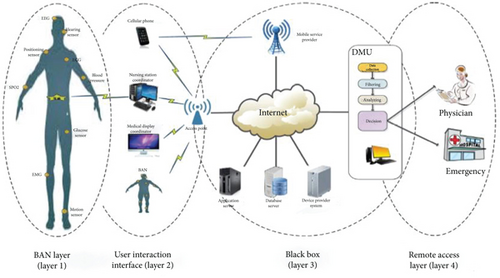
2. Related Work
The goal of this section is to provide the literature review which is based on the description of the existing routing schemes related to WBAN. In this chapter, routing schemes related to WBAN are discussed which are based on WSN. The efficiency and reliability of WBAN depends on the system response, to send and receive the information between the sensor nodes, which eventually depends on the selected routing scheme or protocol to be used. Although many routing schemes had been designed for WSNs but neither any energy-efficient scheme/protocol had been designed for WBAN. For the WBAN framework, the major focus is on minimal routing overhead, minimum energy consumption, and maximum throughput. WSNs are typically designed for homogenous networks, and WBANs are designed for heterogeneous networks. The classification of routing protocols for WBAN is based on multiple schemes. The routing protocols in WBAN are classified into further subtype-based routing topologies. The classification includes QoS aware routing protocols, temperature aware routing protocols, cluster-based routing protocols, postural movement based routing protocols (cost-effective routing), and cross-layered routing protocol [4]. The lifetime of biomedical sensor nodes contributes towards an important role in healthcare applications [1]. The small thermal and battery-powered sensor nodes, working in ad hoc infrastructure, provides the maximum benefit when they communicate with each other for the maximum amount of time [6]. The larger area of the network provides an optimal interface for sensor nodes to communicate with each other and monitors the maximum amount of events in ad hoc wireless infrastructure [7, 8], where the routing technique plays an important part in the energy efficiency of wireless sensor nodes [9]. In WBAN, the shortest path selection within multiple clusters is the optimal routing strategy used within ad hoc wireless infrastructure. The routing protocol and clustering technique should be flexible enough that if we could add additional sensor nodes in the network field, it should be capable of routing the data efficiently from one node to another within each cluster [10, 11]. Typically, wireless sensor nodes avoid direct communication with the head node or sink node due to the high-energy consumption factor [12]. It is feasible that sensor nodes communicate with other sensor nodes to communicate with a head node within each cluster [13]. In many WBAN-based applications as the energy of sensor nodes is depleted, the performance of the network becomes degraded. The reason is the power dissipation over the head of sensor nodes. Latest WBAN protocols can cater to this communication overhead [14, 15]. The core objective of the data aggregation technique in WBAN is to gather the data by the sink node in an energy-efficient manner so that the network lifetime is enhanced [16].
2.1. Limitations in the Existing Literature
- (i)
The DSDV protocol is based on the AODV- and DSR-based routing protocols. The DSDV protocol has poor routing performance as compared to existing schemes. The packet loss ratio in case of the DSDV protocol is very high almost 90%., which creates a high routing mechanism overhead. The routing table is neither capable to successfully updated in case of the DSDV protocol [18]
- (ii)
The DSDV protocol eliminates the base station as mentioned in the existing literature. [18]. This creates a bottle neck for data transmission between the access point and base station in layer 3.This scenario results in data packet loss as well as communication blockage being established between the layer 3 and layer 4. The health care information system in layer 4 is unable to receive any data/packet information from layer 3—at the base station by using the DSDV protocol
3. Classification of Routing Protocols in WBAN
The classification of routing protocols will be categorized in different categories which are based on research challenges related to WBAN. Figure 2 describes about the existing routing schemes, which are mainly categorized as cluster-based routing, postural movement based routing, cross-layered routing, quality of service (QoS) aware routing, and temperature-aware routing schemes [19].
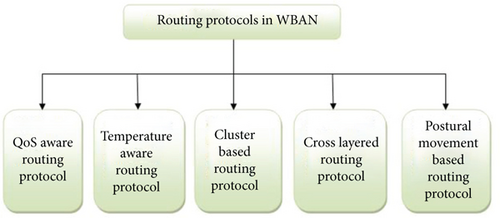
4. Comparison and Evaluation Criteria for Energy-Efficient Routing Protocols
Section 4 describes in deep detail about the comparison and evaluation framework. The evaluation framework in this research study is based on the parameters as described in Table 1. The framework parameters to be considered includes energy efficiency, routing, clustering, communication and network infrastructure, delay and packet loss ratio, security, and types of the wireless sensor network used. Each evaluation framework parameter is further subclassified into subparameters based on its functionality. This section describes the detailed information about the analysis and discussion based on the literature review. The evaluation framework parameters are based on energy efficiency techniques in wireless body area networks. The evaluation framework parameters are energy efficiency, routing, clustering, communication and network Infrastructure, delay packet loss ratio, security, and wireless sensor network type used. The evaluation framework parameters are allocated score based on their core functionality and deployment in health care applications. The evaluation framework parameters are also subcategorized into subparameters along with the score allocated for each subdivision parameter.
| Evaluation framework parameters | Subparameter 1 | Subparameter 2 | Subparameter 3 | Subparameter 4 |
|---|---|---|---|---|
|
Single/multihop routing (score = 4) | Quality of service (score = 3) | RT delay (score = 2) | Radio optimization (score = 1) |
| Routing (score = 6) | Location-based routing (score = 2) | Multipath-based routing (score = 2) | QoS-based routing (score = 2) | — |
| Clustering (score = 6) | Cluster topology (single hop) (score = 2) | Cluster topology (multihop) (score = 2) | CH selection (score = 2) | |
|
Coverage area-triangle/square/hexagon (score = 2) | Energy consumption (score = 2) | Medical WSN deployment (score = 2) | — |
| Delay/packet loss ratio (score = 6) | RSSI (score = 2) | Hop count (score = 2) | Per-hop round trip time RTT (score = 2) | — |
| Security (score = 4) | Confidentiality (score = 1) | Integrity (score = 1) | Authentication (score = 1) | Access control/nonrepudiation (score = 1) |
|
Homogenous WSN (score = 2) | Heterogeneous WSN (score = 2) | — | — |
Table 2 describes about the grading and classification of existing routing protocols in WBAN.
| Author | Energy efficiency (score = 10) | Routing (score = 6) | Clustering (score = 6) | Communication/network infrastructure (score = 6) | Delay/packet loss ratio (score = 6) | Security (score = 4) | WSN types (score = 4) | Total score (42) |
|---|---|---|---|---|---|---|---|---|
| Khan et al. [6] | 2 | 2 | 0 | 6 | 6 | 0 | 2 | 18 |
| Sahndhu et al. [7] | 4 | 2 | 0 | 6 | 6 | 0 | 2 | 20 |
| Liang et al. [8] | 4 | 2 | 0 | 4 | 4 | 0 | 2 | 16 |
| Ahmad et al. [9] | 8 | 4 | 6 | 2 | 2 | 0 | 4 | 26 |
| Javaid et al. [10] | 2 | 4 | 0 | 2 | 2 | 0 | 4 | 14 |
| Abreu et al. [11] | 2 | 2 | 0 | 4 | 4 | 0 | 2 | 14 |
| Bradai et al. [12] | 2 | 0 | 0 | 2 | 2 | 0 | 2 | 8 |
| Elias [13] | 6 | 2 | 0 | 6 | 6 | 2 | 2 | 24 |
| Ahmed et al. [14] | 10 | 6 | 0 | 4 | 4 | 1 | 0 | 25 |
| Haseeb et al. [15] | 6 | 6 | 2 | 2 | 2 | 0 | 2 | 20 |
| Mangali and Kota [16] | 4 | 2 | 4 | 4 | 4 | 1 | 0 | 19 |
| Sabet and Naji [20] | 2 | 2 | 0 | 6 | 6 | 1 | 2 | 19 |
| Mukhtar and Chaudhary [21] | 2 | 2 | 4 | 2 | 2 | 3 | 2 | 17 |
| Murthy et al. [22] | 6 | 2 | 0 | 2 | 2 | 0 | 0 | 12 |
| Raja and Kiruthika [23] | 4 | 0 | 0 | 2 | 2 | 4 | 2 | 14 |
| Chen [24] | 6 | 6 | 2 | 4 | 4 | 0 | 4 | 26 |
| Zeng and Dong [25] | 2 | 2 | 0 | 4 | 4 | 0 | 2 | 14 |
| Javaid et al. [26] | 2 | 2 | 0 | 4 | 4 | 0 | 2 | 14 |
| Nadeem et al. [27] | 2 | 0 | 0 | 0 | 0 | 0 | 0 | 2 |
| Ha [28] | 6 | 6 | 6 | 4 | 4 | 0 | 0 | 26 |
| Javaid et al. [29] | 6 | 4 | 0 | 4 | 4 | 0 | 0 | 18 |
| Javaid et al. [30] | 2 | 2 | 0 | 4 | 4 | 0 | 2 | 14 |
| Kim and Lee [31] | 2 | 2 | 2 | 6 | 6 | 0 | 2 | 20 |
| Aslam et al. [32] | 6 | 2 | 2 | 4 | 4 | 0 | 2 | 20 |
| Sodhro et al. [33] | 2 | 0 | 0 | 2 | 2 | 0 | 0 | 6 |
| Khan et al. [34] | 2 | 4 | 0 | 0 | 2 | 0 | 0 | 8 |
| Rathee et al. [35] | 2 | 0 | 0 | 4 | 0 | 0 | 0 | 6 |
| Kim et al. [36] | 2 | 0 | 0 | 2 | 2 | 0 | 0 | 6 |
| Meng et al. [37] | 0 | 2 | 4 | 0 | 2 | 0 | 0 | 8 |
| Chang and Ju [38] | 6 | 2 | 2 | 2 | 2 | 0 | 2 | 16 |
The energy efficiency classification is based on the further subdivision parameters including single-/multihop communication, quality of service, real time delay, and radio optimization technique used. Ahmed et al. [14] had achieved the highest score in the energy efficiency framework table based on subdivision parameter classification. Ahmad et al. [9] had also achieved the second highest score in the energy efficiency framework table but neglecting an important subdivision parameter named as quality of service in energy-efficient wireless body area networks. Table 2 describes about the routing information subparameter classification table. The routing table is based on further subdivision parameters including location-based routing, multipath-based routing, and quality of service-based routing. Ahmad et al. [14], Haseeb et al. [15], and Chen [24] had achieved the highest score and focused their research on using energy-efficient routing schemes in wireless body area sensor networks. The clustering table is based on further subdivision parameters including topology for single-hop/multihop communications and cluster head selection. Ahmad et al. [9] had achieved the highest score in the clustering table and contributes its important role in energy-efficient routing and clustering techniques in wireless body area sensor networks. Table 2 describes about the communication and network infrastructure subparameter classification table. The communication and network infrastructure is based on further subdivision parameters which includes the wireless sensor network coverage area [39]. The coverage area may be triangular, square, and hexagonal for sensor network deployment. The second subdivision parameter is the energy consumption factor in case of the wireless body area sensor network during the communication purpose for a designated coverage area. The last subdivision parameter is the medical wireless sensor network deployment scheme used during the health care sensor network communications. Khan et al. [6], Sahndhu et al. [7], Elias [13], Sabel et al. [20, 40], and Kim and Lee [31] had critically analyzed and deployed the medical sensors within the designated coverage area using an energy-efficient wireless sensor network scheme [41]. The delay packet loss ratio can also be further categorized into subdivision parameters including RSSI (received signal strength intensity), hop count, and per hop round trip time. Ling et al. [8], Javid et al. [10], Bradi et al. [12], Elias [13], Haseeb et al. [15], Zeng and Dong [25], and Javed et al. [29, 30] had achieved the highest score in the delay packet loss ratio related to wireless body area sensor networks in the health care domain [42, 43]. Security issues can further be subcategorized into subdivision parameters including confidentiality, integrity, authentication, and access control/nonrepudiation [44, 45]. Raja and Kiruthika [23] had achieved the highest score in security issues using encryption and decryption schemes for health care using wireless sensor networks. WSN for health care systems can further be categorized into subdivision parameters including homogenous wireless sensor networks and heterogeneous wireless sensor networks. Ahmad et al. [9], Javaid et al. [10], and Chen [24] had achieved the maximum score in wireless sensor network types and its deployment scheme in health care networks by using na energy-efficient framework [46, 47]. Figure 3 describes the graphical representation of evaluation framework parameters’ total score versus reference based on the research work.
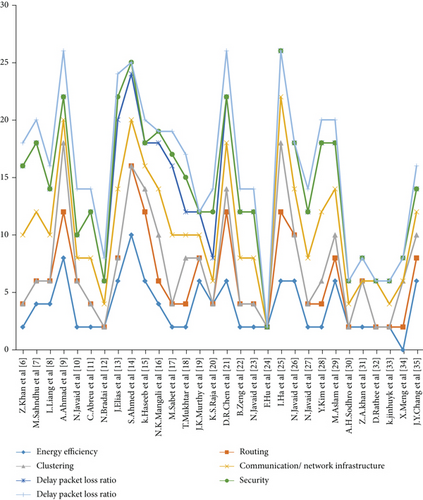
5. Conceptual Model for Energy-Efficient Framework for Wireless Body Area Sensor Networks (WBAN)
The conceptual model for the energy-efficient framework for wireless body area sensor networks is designed by using a five-tier framework architecture as mentioned in Figure 4 below.
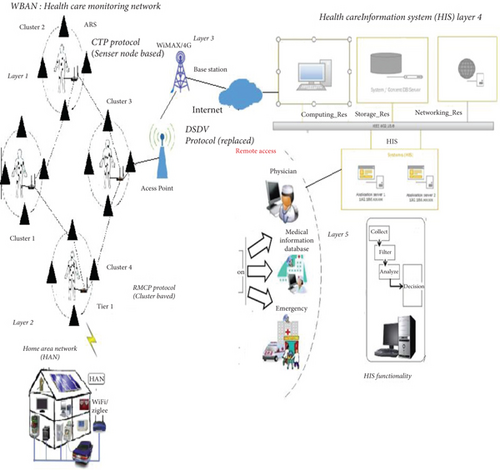
5.1. Proposed Solution
The proposed solution related to the existing system is based on the wireless body area network for the health care system.
5.1.1. Network Architecture
The network architecture for the wireless body area sensor network consists of the following major components and 5 layers.
- (i)
ARS
- (ii)
RN
- (iii)
Sensor nodes
Sensor nodes are mounted on the human body. Sensor nodes are capable to transmit the health status information to the RN. The classification of the sensor nodes are categorized into the following subtypes including a heart beat sensor, pulse rate, glucose level, blood pressure, and body temperature [18].
(2) Access Point (AS) and Base Station (BS) (Layer 2). The access point is capable to receive the disaster-based health care information from sensor nodes within each cluster via ARS. The AS is also responsible to transmit the health care critical information to the base station [5, 18].
(3) Health Care Information Systems (HIS) (Layer 3). The proposed health care information system is connected to the base station via the Internet. The HIS consists of computing resource, storage resource, and networking resource. The HIS is also responsible for intelligent health status analysis and intelligent decision making. Layer 3 is based on data management application which consists of doctors to access the hospital information server by using the Internet. The HIS is connected to the Internet by using the WIMAX/4G-LTE infrastructure. The data from the gateway node is transferred to the database management server by using the Internet as a transmission medium. The doctors and health care professionals can access this data from the DBMS server by using the Internet [51, 52].
(4) Home Area Network (HAN) (Layer 4). The HAN provides an efficient solution of smart home. It is typically designed for elderly people living in houses. Sensor nodes are deployed on almost every home appliance and also deployed on the human body, thus possibly forms an ad hoc network within the fixed defined range. The HAN is also interfaced with HIS via the Internet [53, 54].
(5) Remote Access (Layer 5). The remote access at layer 5 provides the health status information of an individual from layer 4 health care information system. The health status information received from layer 4 is helpful for the doctors and health care experts in intelligent clinical diagnosis and also for useful for emergency rescue authorities including ambulances and hospital staff for emergency rescue operations [55].
5.1.2. Communication Protocol Model Used in WBAN (Health Care Monitoring Network)
- (i)
CTP protocol (collection tree-based protocol-sensor node based)
- (i)
Reliability: the protocol delivers at least 90% of end-to-end packets when a route exists, even under challenging network conditions. 99.9% packet delivery is achievable in case of the proposed scheme [56]
- (ii)
Robustness: the protocol is capable to operate in a wide range of network conditions including extensive network workloads, network topologies, and network environments [57]
- (iii)
Efficiency: the protocol is capable to transmit the packets with the minimum amount of times across the wireless network [58]
- (iv)
Hardware independence: the protocol is able to work on large number of hardware platforms [59]
- (ii)
RMCP protocol (reliability based on cluster member density and event proximity-cluster based)
RMCP is a reliable cluster-based routing scheme which is termed as the reliable mobile ad hoc sensor network protocol. In order to efficiently and reliably deliver, sensing data using sensors remains a great research challenge. Multipath allows an easy mechanism to distribute traffic and balance network’s load and also supports fault tolerance. RMCP guarantees quality of service and has much better performance than the existing protocols in terms of energy efficiency, end-to-end delay, and packet delivery ratio [60, 61].
- (iii)
DSR-based protocol (route discovery-based protocol)
- (iv)
DSDV-based routing protocol (route discovery-based protocol)
The destination-sequenced distance vector (DSDV) routing protocol is a proactive routing protocol. The DSDV protocol is based on AODV- and DSR-based routing protocols. The DSDV protocol is used in data transmission between the access point and base station in layer 3.
5.1.3. Research Contribution (Modified Version of DSDV-Based Routing Protocol Based on RMCP)
- (1)
RMCP utilizes an efficient clustering technique which is based on a patient’s health condition. The current scenario is based on 150 sensors deployed in the network field. Wireless sensor networks in this current scenario can maintain a packet data ratio greater than 80%, which is suitable for hospitals and health care institutions. RMCP supports efficient data transmission and routing mechanism for doctors/nurses who move around in a health care environment
- (2)
The limitation of packet loss ratio in the DSDV protocol is supported by the RMCP protocol in case of wireless body area sensor networks
6. Simulation Results and Experimentation
This section provides a comparative analysis of the proposed protocol (M-DSDV-RMCP) with existing routing protocols DSDV and RMCP. The simulation results had been obtained in MATLAB version 12.0. The simulation results obtained are based on the number of packets sucessfully transmitted versus 200 numbers of iterations as shown in Figure 5.
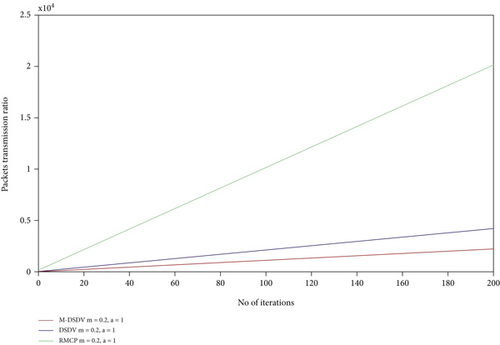
From the simulation results, it has been observed that the performance of the M-DSDV-RMCP protocol is better than the DSDV and RMCP routing protocols due to the maximum no. of packets transmitted from the source node to the sink node.
7. Conclusions and Future Work
The conclusions of the research work is based on the development of the RMCP protocol, which is capable to successfully route the data from the access point to the base station in layer 3. These results in the successful packet delivery ratio from layer 3—which is communication infrastructure towards layer 4—which is the health care information system for strong analysis and decision-making by doctors and health care institutions at layer 5. The new protocol is assumed to be named as the modified version of the DSDV protocol based on the RMCP protocol. The M-DSDV-RMCP-based routing protocol supports a successful packet delivery ratio between layer 3 and layer 4. The future work relies on the integration of IOMT (Internet of Medical Things).
Conflicts of Interest
The authors declare that they have no conflicts of interest.
Open Research
Data Availability
No data were used to support this study.




